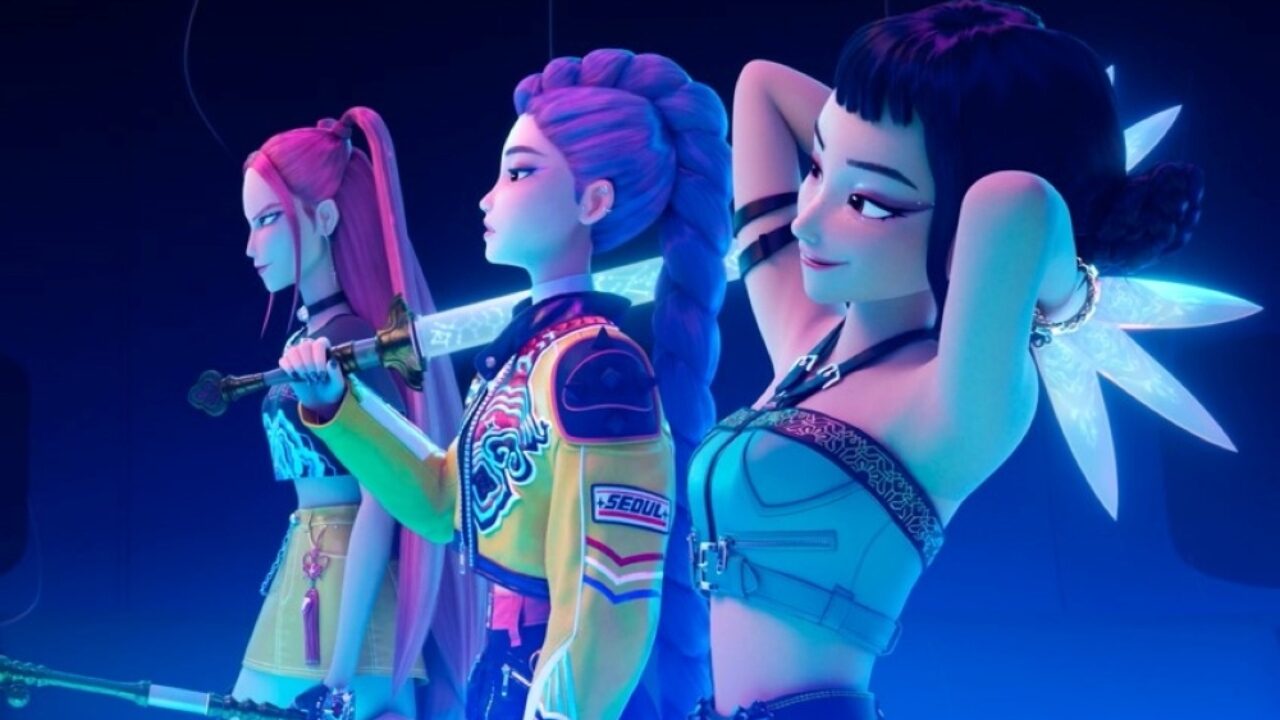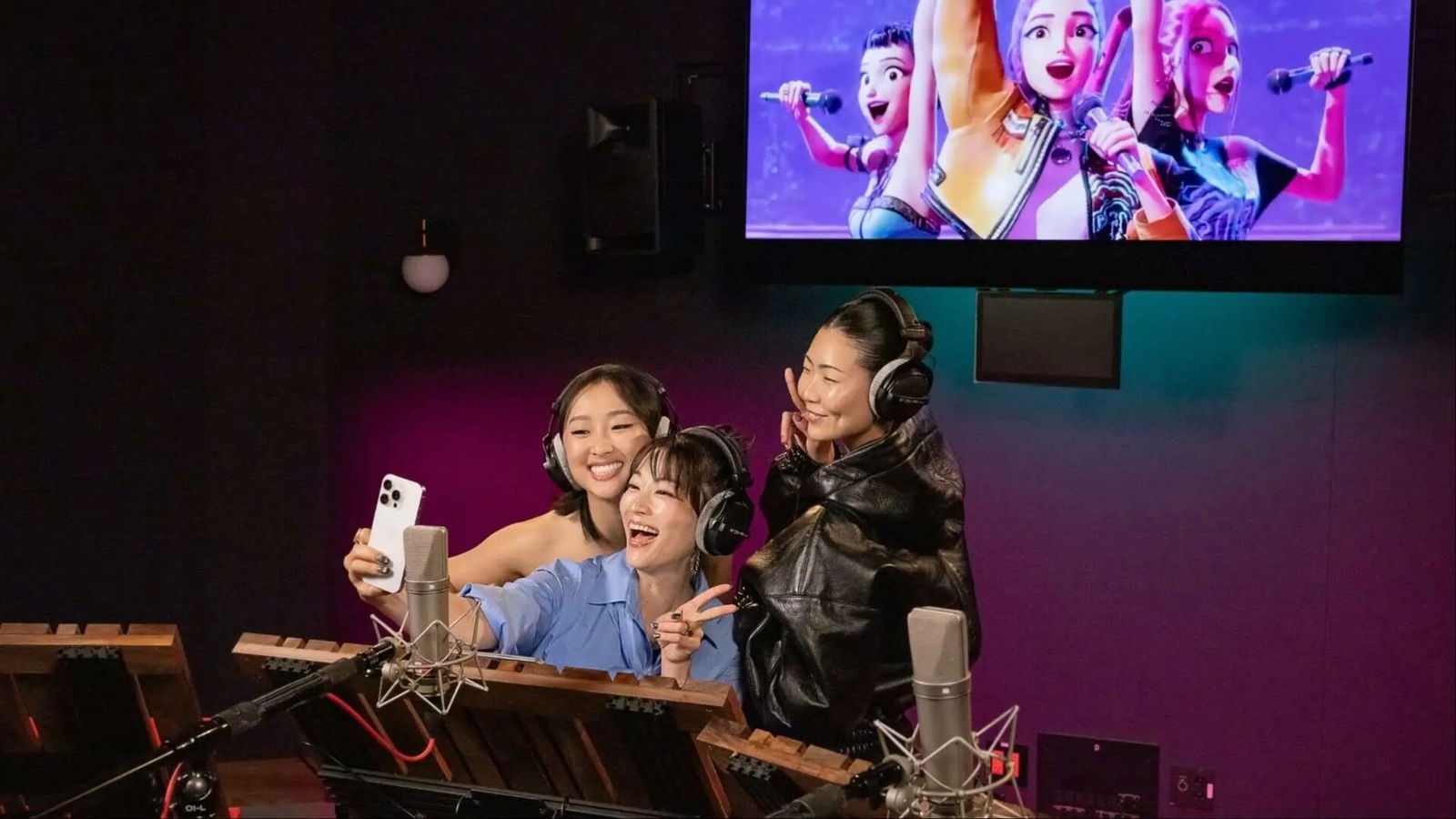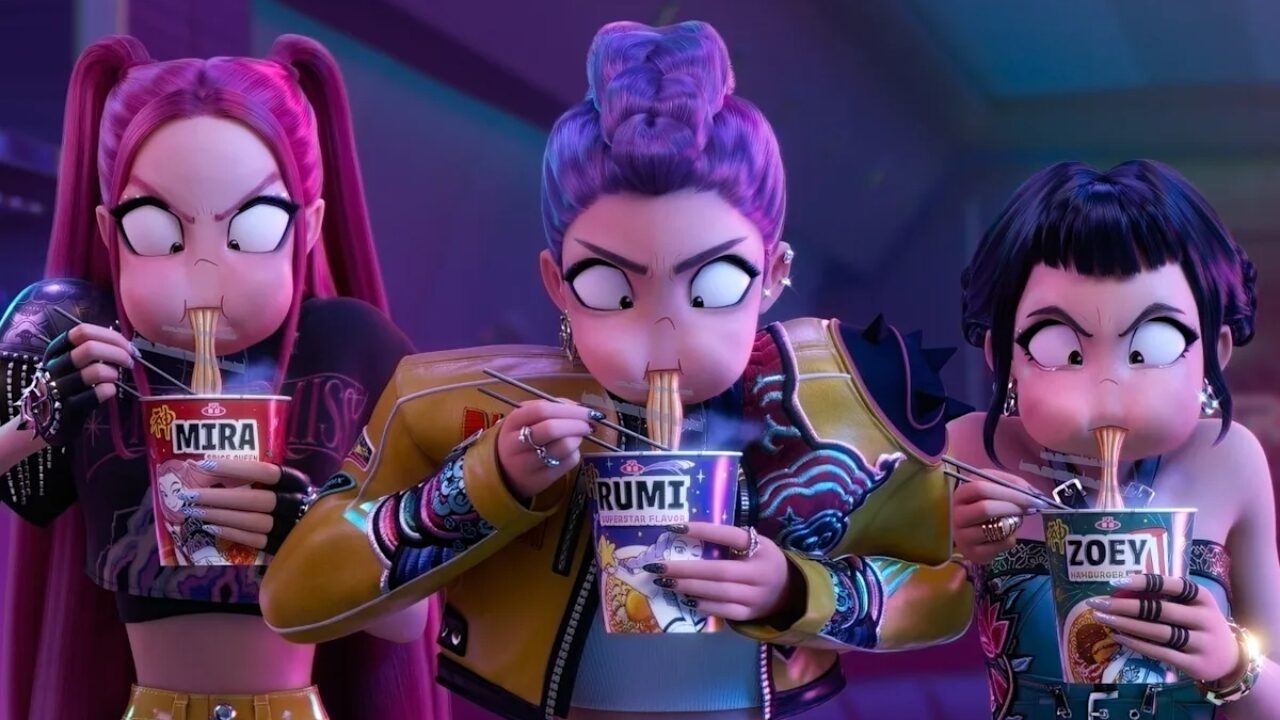There is no doubt that Netflix and Sony Pictures Animation’s KPop Demon Hunters have taken the globe in 2025, since its release on the streamer. In general, K-pop has been entering the more mainstream music scene around the world, closer to the 2010s when PSY’s Gangnam Style went viral in 2012. This was also the peak time of music videos on YouTube. As the 2010s progressed, BTS (aka the Bangtan Boys) debuted in 2013 and really won the hearts of many people everywhere. I would argue Big Bang laid the foundations in the early 2000s to appeal to a more Western audience. But BTS skyrocketed the genre globally, doing various collabs from Fortnite to McDonald’s.
Now, a fictional K-pop group called HUNTR/X from KPop Demon Hunters has been blowing up since this past summer. I say fictional, but there are real voices behind these characters. Real voices that can act and sing. Arden Cho (Rumi), May Hong (Mira), and Ji-young Yoo (Zoey) brought the emotions and story to these characters, while EJAE (Rumi), Andrey Nuna (Mira), and Rei Ami (Zoey) brought their beautiful vocal talents to the trio’s voices. Recently, the three music artists performed live for the first time on The Tonight Show Starring Jimmy Fallon. All to say, HUNTR/X can be as real as the voices behind them.
CGMagazine had the amazing opportunity to sit down and talk with one of the visionaries behind KPop Demon Hunters, co-director Chris Appelhans, at SCAD AnimationFest 2025. We discussed Appelhans’ favourite K-pop groups, and delved deeper into assembling the powerhouse voices behind the animated, iconic female K-pop girl group. While a second chapter has not been officially announced by Netflix and Sony Pictures Animation, Appelhans stated how much he loved working with these spectacular women who bring HUNTR/X to life—including his wonderful co-director Maggie Kang.
With Kpop Demon Hunters being a fantastic genre mashup of supernatural, fantasy with music, I’m curious if you were a K-pop enjoyer before working on this project, or did you become one during the making of this film?
Chris Appelhans: Yeah, Rain was my first K-pop crush. That was around 2007-2008. And then over the years, I watched it grow, and I watched the musicianship and the production get more high-level. The last four or five years, artists like Sunmi really blew me away, like there’s just so much rawness and personality in her music. And then, obviously, BTS. I think BTS galvanized both Maggie and me because we were suffering through the pandemic, and they were doing all those virtual concerts.
[Meanwhile], the whole time we’re talking, ‘we’re making this movie about the power of music, but it’s cheesy. Is this going to work?’ And then we’re like, ‘Wait, it’s literally happening right now.’ Everyone around the world is happy because these seven guys are dancing and singing their great music. So yeah, I think it’s about 20 years or so [of enjoying K-pop]. But I’ve been a lifelong musician, so I think my deeper connection to the movie is as a musician and as a person who’s written songs and lived music as long as I can remember.
Yes, and I read a bit about how creating KPop Demon Hunters’ soundtrack took around three years.
Chris Appelhans: Four years, actually. Yeah, it was four years from the first demo that EJAE did.
Wow, four years, sorry! When HUNRT/X is trying to write their final, big song in the film. I was curious if that was a reflection of both of your processes and everyone’s process on the music for this film, before or after writing the initial story?
Chris Appelhans: One of the things we really wanted to use the songs for was always to advance the story, and that included the relationship of the girls. So the songs that the girls sing represent the stages of their thinking. The first song, How It’s Done, is this declarative banger—like, we’re here; we’re badass; you can’t touch us; we’re going to protect the world, right?
Golden is a little bit more about how we have fears and insecurities; we started as zeros, and now we’re heroes. It’s more vulnerable and a little more like, we’re so close to our dream. Then, Takedown is really a misfire in their growth as people. It’s very one-dimensional, black and white, and it’s everything that they’ve been taught that’s maybe overly harsh. It’s obviously targeted at the Saja Boys, but really, it’s written to sort of target Rumi, right?
Inadvertently, [Rumi’s] realizing that Mira and Zoey have a really harsh and simple view of demons, [not good and bad demons, just demons]. So, the fact that they were writing the song together was a good plot point because I got to write a song to fight the Saja Boys, but it was also a vessel for us to show the audience how Rumi was questioning everyone’s worldview, and Mira and Zoe weren’t in that same headspace. It was a way of showing the audience this group that seems so together actually aren’t on the same page in some big ways.

Definitely. And on mentioning Mira and Zoey, we get a lot more of Rumi’s backstory in KPop Demon Hunters compared to Mira and Zoey. I know you probably have all the ideas already, but is that something that could be further explored down the line?
Chris Appelhans: I think it totally could. Nobody’s made any decisions about the next chapter. But I think one of the things that I love about their story, if you’ve seen any interviews with Rei Ami or Ji-Young Yoo, all the voice actresses and singers really relate to their fictional character. They each have really interesting individual backstories that kind of mirror the fictional ones.
So there’s always value in knowing more about the specifics. But sometimes the beautiful thing about a story is giving people a little bit of the details they want, without getting too specific; they can inhabit the idea a little bit. I know Zoey’s backstory, but when Rei Ami told me her backstory, I’m like, ‘This is amazing too,’ and it’s about the same thing.
It’s always this dance when you’re writing characters, to tell everybody exactly who they are and where they came from. [But you can] also withhold some stuff, so that people can put themselves in there and just relate to that universal thing that the character is going through.
Yeah, and I thought it was such a huge process blending the singers with actresses. It’s very interesting hearing about how you wanted to bridge that gap.
Chris Appelhans: I think the reason each character feels seamless, even though it’s two different women, is that both the actress and singer are really related to the character, and the way they inhabited them was personal. Somehow, that creates the illusion that it’s all one soul inside these characters. But I would say that Maggie deserves a lot of credit for dreaming up this idea when she did. Without the platform of this story and this film, EJAE, Rei, Audrey, and all these women [wouldn’t] have had this place to show who they are.
That’s one of the things about making films is if you are doing the right film at the right time, the universe tends to provide you with the necessary pieces. How crazy is it that these amazing women showed up and all had the talents necessary to pull this off? It’s a credit to the fact that finally, somebody planted a flag and said, ‘Let’s make a movie like this.’ And they all said, ‘I will be in that movie’. I love that. I think it’s why it’s important to keep doing original stuff in film and animation because the world is changing, and so our artwork should be changing too.

That’s amazingly put. Last question, I was hoping you could speak more on what went on behind one of my favourite scenes, the opening fight sequence on the plane.
Chris Appelhans: It was really collaborative. We had some great board artists on the show who boarded different passes of that and allowed us to figure out the structure. We also had some really comedic through lines in terms of the girls loving food. As much as they wanted to fight demons, what they really cared about was their dang ramyeon. The idea that they’re so badass that being attacked in an airplane at 30,000 feet by a bunch of demons that want to kill them is mostly a nuisance.
It’s really just like, ‘Can I just eat, damn it? ‘ So I think that conceit was really fun and playful, and then writing the song, like I said, is kind of just a catharsis, of like, let’s make a banger that’s basically ‘don’t get in our way.’ And then the choreography of the animation was a very carefully figured-out thing. With our amazing animation team, [there were] lots of reference videos.
We have some animators who would do the blocking pass, where they would draw in 2D some of those crazy continuous shots where it’s here, and then the camera is here, and then people overlap. They would do a 2D pass at that—to get it visually working—and then we’d sort that out in 3D. [For] the airplane, we have two airplanes. One is the first half of the scene, and when the song starts, it gets twice as big, but you don’t notice because it’s just hidden in the cut. So yeah, so many shenanigans.

KPop Demon Hunters is currently streaming on Netflix and was released on the streamer on June 20, 2025. A special re-release in theatres is coming back in time for Halloween!





